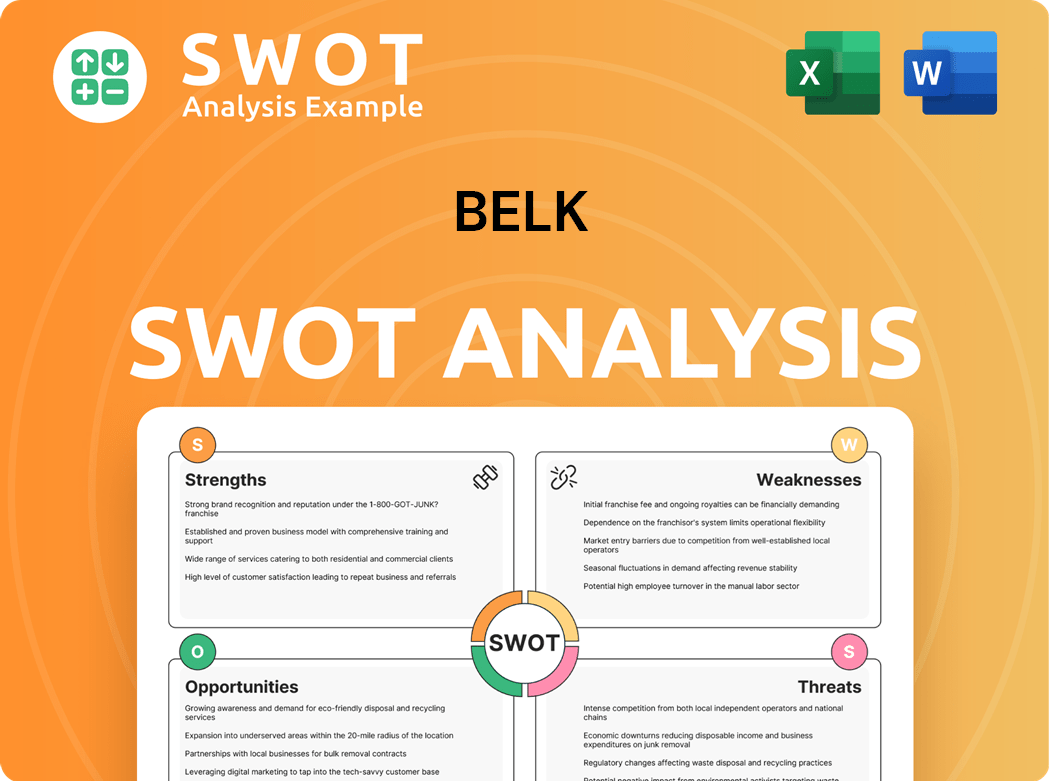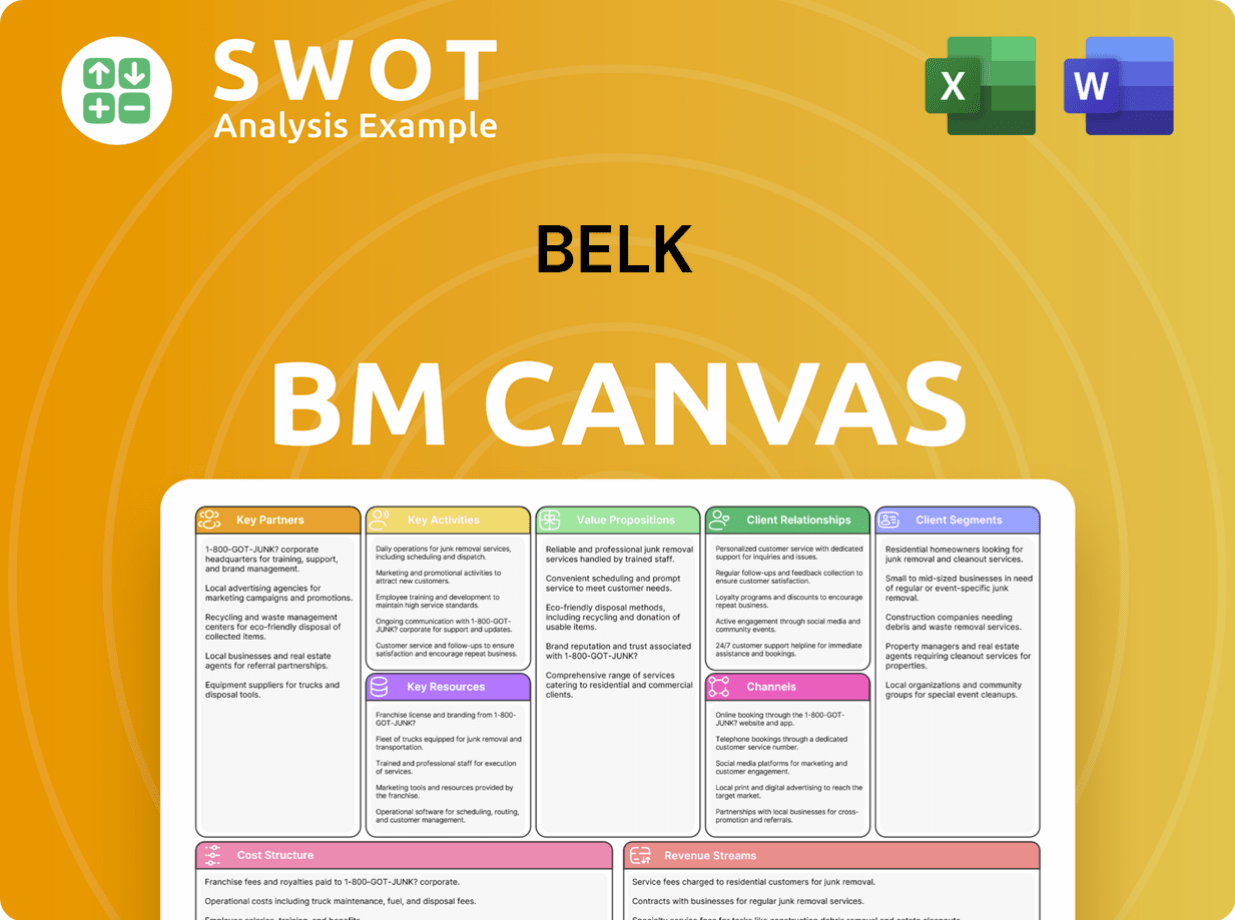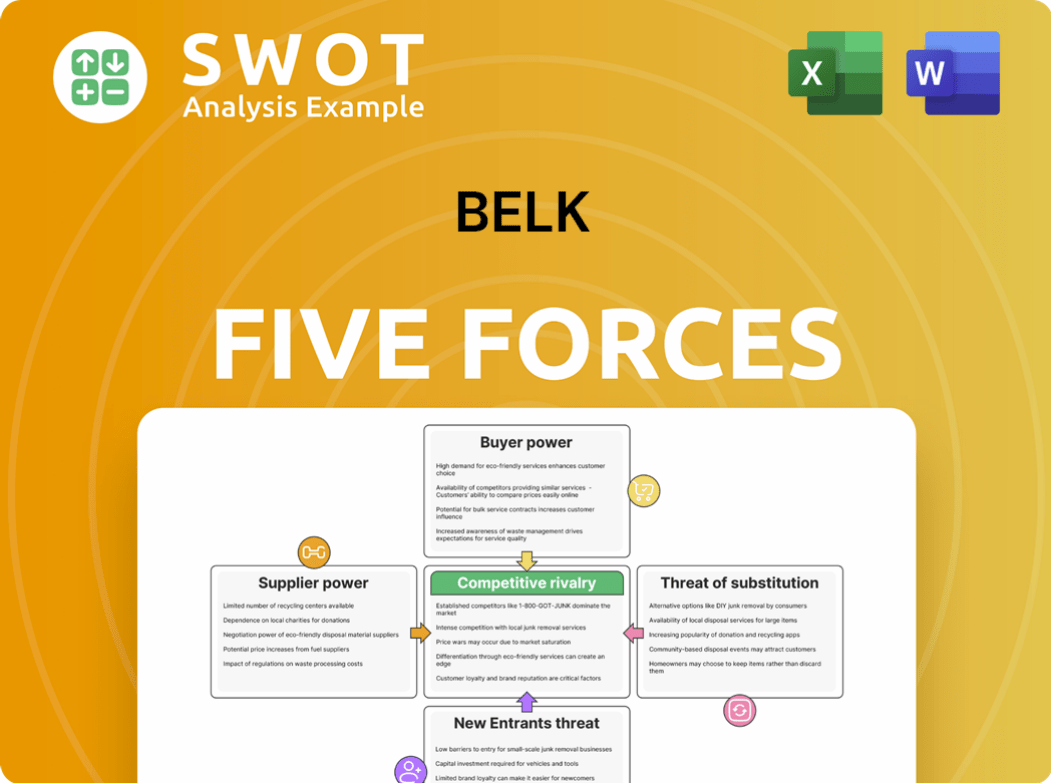Belk Bundle
How well do you know the Belk Company?
Journey back in time to explore the captivating Belk SWOT Analysis and the remarkable story of the Belk department store. From its humble beginnings in the late 19th century to its current status as a retail powerhouse, Belk's history is a testament to adaptability and a commitment to customer value. Discover how this Southern retail icon has evolved through the years.

The brief history of Belk department stores reveals a fascinating narrative of innovation and resilience. Founded in 1888, the Belk company quickly distinguished itself in early retail history by embracing fixed prices and money-back guarantees. Today, with nearly 300 Belk stores across the South, the company continues to adapt and thrive, maintaining its legacy in the dynamic retail landscape.
What is the Belk Founding Story?
The story of the Belk department store, a cornerstone of Southern retail, began on May 29, 1888. This is a brief history of Belk department stores. Founded by William Henry Belk, the company's humble beginnings laid the foundation for its future success. The early days of Belk offer insights into the innovative strategies that propelled its growth.
The Belk company's founding is a testament to entrepreneurial spirit and innovative business practices. Belk's initial store, a modest 1,500 square feet in Monroe, North Carolina, marked the start of a retail empire. His vision and early business model set the stage for its expansion and enduring presence in the retail landscape.
The early history of Belk department stores reveals a commitment to value and customer satisfaction. Belk's innovative approach, which included fixed prices and a customer satisfaction guarantee, set it apart from competitors. This focus on providing better value and building trust with consumers was key to its early success and laid the groundwork for its future growth. Learn more about the Growth Strategy of Belk.
William Henry Belk founded the 'New York Racket' store at age 26. He started with $750 in savings and a $500 loan.
- The initial store was approximately 1,500 square feet.
- Belk's slogan was 'Cheap Goods Sell Themselves.'
- He secured around $3,000 worth of goods on consignment.
- Within seven months, Belk achieved a profit of $3,300.
Belk's early success was due to its pioneering business practices. The company focused on cash purchases and low markups.
- Fixed prices were clearly marked on all merchandise.
- A customer satisfaction guarantee with returns was offered.
- This model contrasted with the credit-based system common in Southern general stores.
- The aim was to provide better value and build consumer trust.
In 1891, Dr. John M. Belk joined the company, leading to its renaming. This partnership was pivotal in driving the company's expansion.
- Dr. John M. Belk, William's brother, became a partner.
- The company was renamed Belk Brothers Company.
- This marked the beginning of significant growth for the company.
- The partnership strengthened the company's foundation for future growth.
Belk SWOT Analysis
- Complete SWOT Breakdown
- Fully Customizable
- Editable in Excel & Word
- Professional Formatting
- Investor-Ready Format

What Drove the Early Growth of Belk?
The early growth of the Belk department store was marked by strategic expansion and a focus on customer value. After the formation of Belk Brothers Company in 1891, the company quickly opened new stores. This rapid expansion set the stage for the company's significant presence in Southern retail. By the early 20th century, the company had established a strong foundation for future growth.
Following the founding of Belk Brothers Company, the second store opened in Chester, South Carolina, in 1893. A third store was established in Union, South Carolina, in 1894. The company's expansion continued with the opening of its fourth store in Charlotte, North Carolina, in 1895, which later became the operational base.
By 1909, the headquarters officially moved to Charlotte. The company's expansion throughout the Southeast was largely driven by a unique partnership model. This model involved investing in local merchandisers, often former employees, who then opened stores under co-branded names.
By 1910, the chain's sales approached $1 million. In 1940, the Belk Buying Service was established to consolidate purchasing power. This allowed the company to buy goods in bulk at favorable prices, enhancing its competitive edge in the Southern retail market.
The 1950s saw further expansion with the opening of the first shopping center store in Florida in 1952. The formation of Belk Stores Services, Inc. occurred in 1955. A significant acquisition was made in 1956 with the rival Efird department stores, further solidifying its market position.
Belk PESTLE Analysis
- Covers All 6 PESTLE Categories
- No Research Needed – Save Hours of Work
- Built by Experts, Trusted by Consultants
- Instant Download, Ready to Use
- 100% Editable, Fully Customizable

What are the key Milestones in Belk history?
The Belk history is marked by significant milestones that have shaped its evolution into a prominent
| Year | Milestone |
|---|---|
| 1888 | William Henry Belk introduced fixed pricing and a money-back guarantee, a revolutionary move for the time. |
| 1940 | The Belk Buying Service was established, centralizing purchasing to secure bulk discounts and maintain competitive pricing. |
| 1952 | The company opened its first store in a shopping center, adapting to the evolving retail formats. |
| 1998 | 112 separate companies were merged into a single entity, Belk, Inc., consolidating operations and brand identity. |
| 2001 | Belk.com was launched, marking the company's entry into e-commerce and adapting to the digital age. |
| 2006 | Belk acquired 40 Parisian department stores, which were later rebranded as Belk stores. |
| 2021 | Belk underwent a financial restructuring, eliminating approximately $450 million of debt and securing $225 million in new capital. |
| 2024 | Belk further reduced its outstanding debt by over $950 million and secured approximately $485 million in new capital, extending its asset-based credit facility to July 2029. |
Innovations have been crucial to the
In 1888, William Henry Belk pioneered fixed pricing and a money-back guarantee, fostering customer trust and setting a new standard in the early retail history. This approach distinguished the company from competitors and built a loyal customer base.
The establishment of the Belk Buying Service in 1940 was a strategic innovation, enabling bulk discounts and competitive pricing. This centralized approach improved efficiency and supported the company's expansion.
Opening stores in shopping centers in 1952 was a key adaptation to evolving retail formats. This expansion strategy ensured accessibility and relevance for customers.
The launch of Belk.com in 2001 was a critical step, marking the company's entry into e-commerce. This move allowed Belk to adapt to the digital age and expand its reach.
The purchase of Parisian department stores in 2006, which were rebranded as Belk stores, expanded the company's footprint. This strategy helped Belk grow its market presence.
In February 2021, Belk underwent a financial restructuring that eliminated approximately $450 million of debt. This move provided $225 million in new capital, supporting future growth initiatives.
The
Belk competes with major retailers like Kohl's, J.C. Penney, Dillard's, Target, and Walmart, creating constant pressure to differentiate. This intense competition necessitates continuous adaptation and innovation.
Economic downturns and shifts in consumer spending patterns pose ongoing threats to profitability and growth. These factors require flexibility and strategic financial planning.
The decline of the traditional department store model and the rise of e-commerce have necessitated strategic pivots. Belk has responded by enhancing its omnichannel capabilities.
The 2021 financial restructuring, backed by Sycamore Partners, aimed to eliminate debt and provide capital. As of July 2024, further debt reduction and new capital secured are ongoing efforts.
Belk's investment in its online presence and omnichannel capabilities is crucial for maintaining relevance. This includes enhancing the online shopping experience.
Revitalizing physical stores through updated designs and product assortment is a key strategy. This approach aims to enhance the shopping experience and attract customers.
Belk Business Model Canvas
- Complete 9-Block Business Model Canvas
- Effortlessly Communicate Your Business Strategy
- Investor-Ready BMC Format
- 100% Editable and Customizable
- Clear and Structured Layout

What is the Timeline of Key Events for Belk?
The Belk company, a significant player in Southern retail, has a rich history marked by strategic growth and adaptation. From its humble beginnings in 1888 as 'New York Racket' to its current status as a major department store chain, Belk's journey reflects its resilience and commitment to the evolving retail landscape. Key milestones highlight its evolution, including mergers, acquisitions, and a focus on digital transformation.
| Year | Key Event |
|---|---|
| 1888 | William Henry Belk opens 'New York Racket' in Monroe, NC, marking the beginning of the Belk department store legacy. |
| 1891 | William Henry Belk partners with his brother, Dr. John M. Belk, and the company becomes Belk Brothers Company. |
| 1895 | William Henry Belk opens a store in Charlotte, NC, which becomes the company's base of operations. |
| 1910 | The chain's sales approach $1 million, indicating early success and expansion. |
| 1940 | Belk Buying Service is established, streamlining operations. |
| 1952 | The first shopping center store opens in Florida, reflecting a shift towards suburban locations. |
| 1956 | Acquires rival Efird department stores, consolidating its market presence. |
| 1983 | Belk hosts its first New York fashion buying show, shifting emphasis to style and trends. |
| 1998 | 112 separate Belk companies merge into one entity, Belk, Inc., simplifying the corporate structure. |
| 2001 | Belk.com is launched, marking the company's entry into e-commerce. |
| 2006 | Belk acquires 40 Parisian department stores, expanding its footprint. |
| 2015 | Sycamore Partners acquires Belk for $3 billion, signaling a new phase of ownership. |
| 2021 (February) | Belk completes a one-day financial restructuring, reducing debt by $450 million and securing $225 million in new capital. |
| 2021 (July) | Don Hendricks is promoted to President, and Nir Patel becomes CEO. |
| 2024 (July) | Belk completes a deleveraging transaction, reducing debt by over $950 million and securing approximately $485 million in new capital, extending its credit facility to July 2029. |
| 2024 (October) | Belk launches the Belk Media Network, powered by Criteo, to connect brands with its customer base. |
| 2025 (April) | Belk shows weekly year-over-year visit growth, indicating pockets of success in the traditional department store segment. |
Belk plans to strengthen its e-commerce segment, which is a significant and growing part of its business. The company is focused on enhancing its online platform to meet evolving customer expectations. This includes improving user experience, expanding product offerings, and optimizing online marketing strategies.
The company intends to revitalize its physical stores through updated designs to create a more inviting and modern shopping environment. This includes store renovations and the integration of new technologies to enhance the in-store experience. The goal is to make Belk stores more appealing and competitive.
Belk plans to continue diversifying its inventory to align with evolving customer lifestyles, including areas like home, wellness, and outdoor. This strategy aims to attract a broader customer base and increase sales. The company is focusing on offering a wider variety of products to meet diverse consumer needs.
Belk recognizes opportunities for expansion into new regions and states to attract new customers and increase sales. While historically concentrated in the Southern states, the company is exploring options to grow its footprint. This includes opening new stores in strategic locations.
Belk Porter's Five Forces Analysis
- Covers All 5 Competitive Forces in Detail
- Structured for Consultants, Students, and Founders
- 100% Editable in Microsoft Word & Excel
- Instant Digital Download – Use Immediately
- Compatible with Mac & PC – Fully Unlocked

Related Blogs
- What is Competitive Landscape of Belk Company?
- What is Growth Strategy and Future Prospects of Belk Company?
- How Does Belk Company Work?
- What is Sales and Marketing Strategy of Belk Company?
- What is Brief History of Belk Company?
- Who Owns Belk Company?
- What is Customer Demographics and Target Market of Belk Company?
Disclaimer
All information, articles, and product details provided on this website are for general informational and educational purposes only. We do not claim any ownership over, nor do we intend to infringe upon, any trademarks, copyrights, logos, brand names, or other intellectual property mentioned or depicted on this site. Such intellectual property remains the property of its respective owners, and any references here are made solely for identification or informational purposes, without implying any affiliation, endorsement, or partnership.
We make no representations or warranties, express or implied, regarding the accuracy, completeness, or suitability of any content or products presented. Nothing on this website should be construed as legal, tax, investment, financial, medical, or other professional advice. In addition, no part of this site—including articles or product references—constitutes a solicitation, recommendation, endorsement, advertisement, or offer to buy or sell any securities, franchises, or other financial instruments, particularly in jurisdictions where such activity would be unlawful.
All content is of a general nature and may not address the specific circumstances of any individual or entity. It is not a substitute for professional advice or services. Any actions you take based on the information provided here are strictly at your own risk. You accept full responsibility for any decisions or outcomes arising from your use of this website and agree to release us from any liability in connection with your use of, or reliance upon, the content or products found herein.